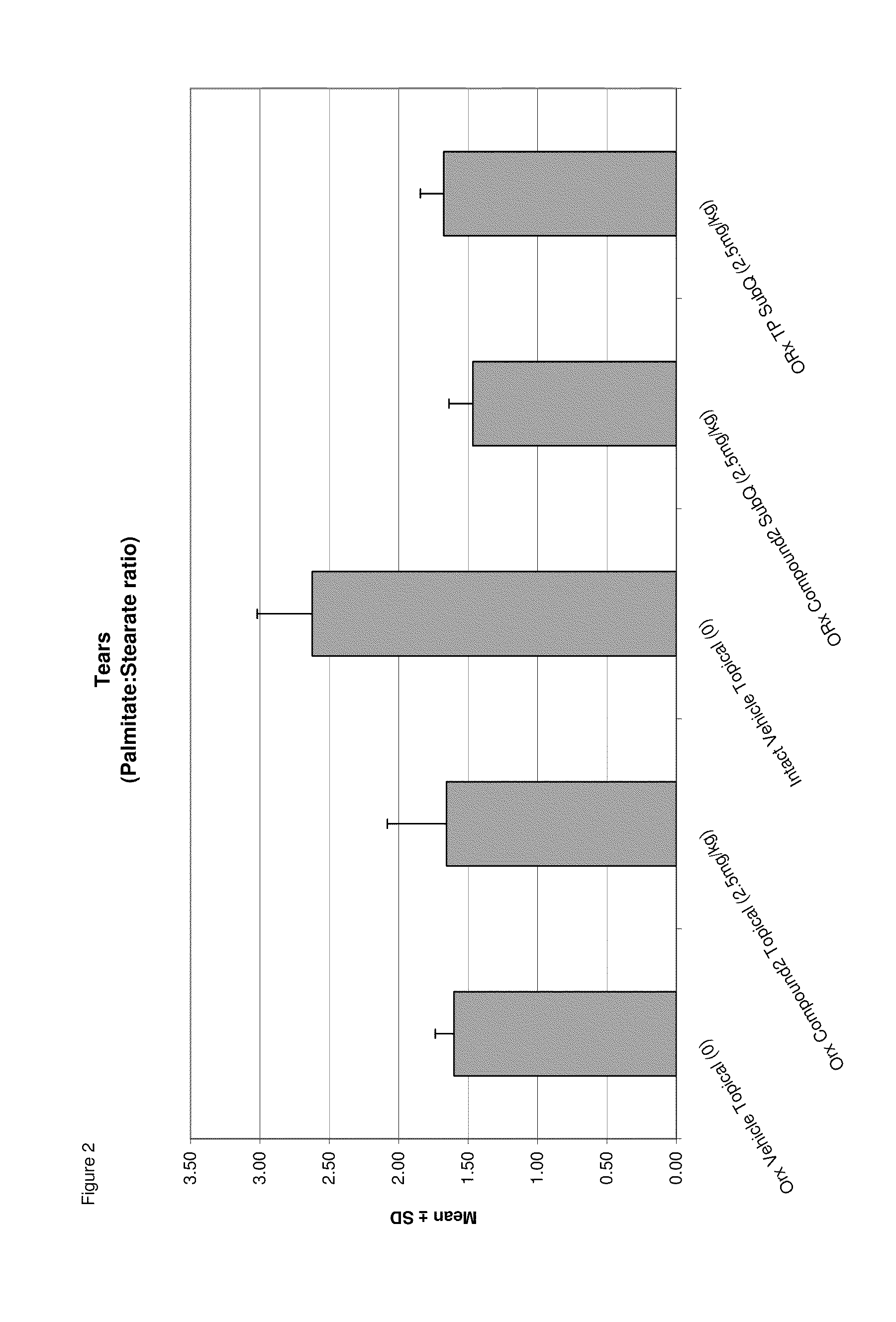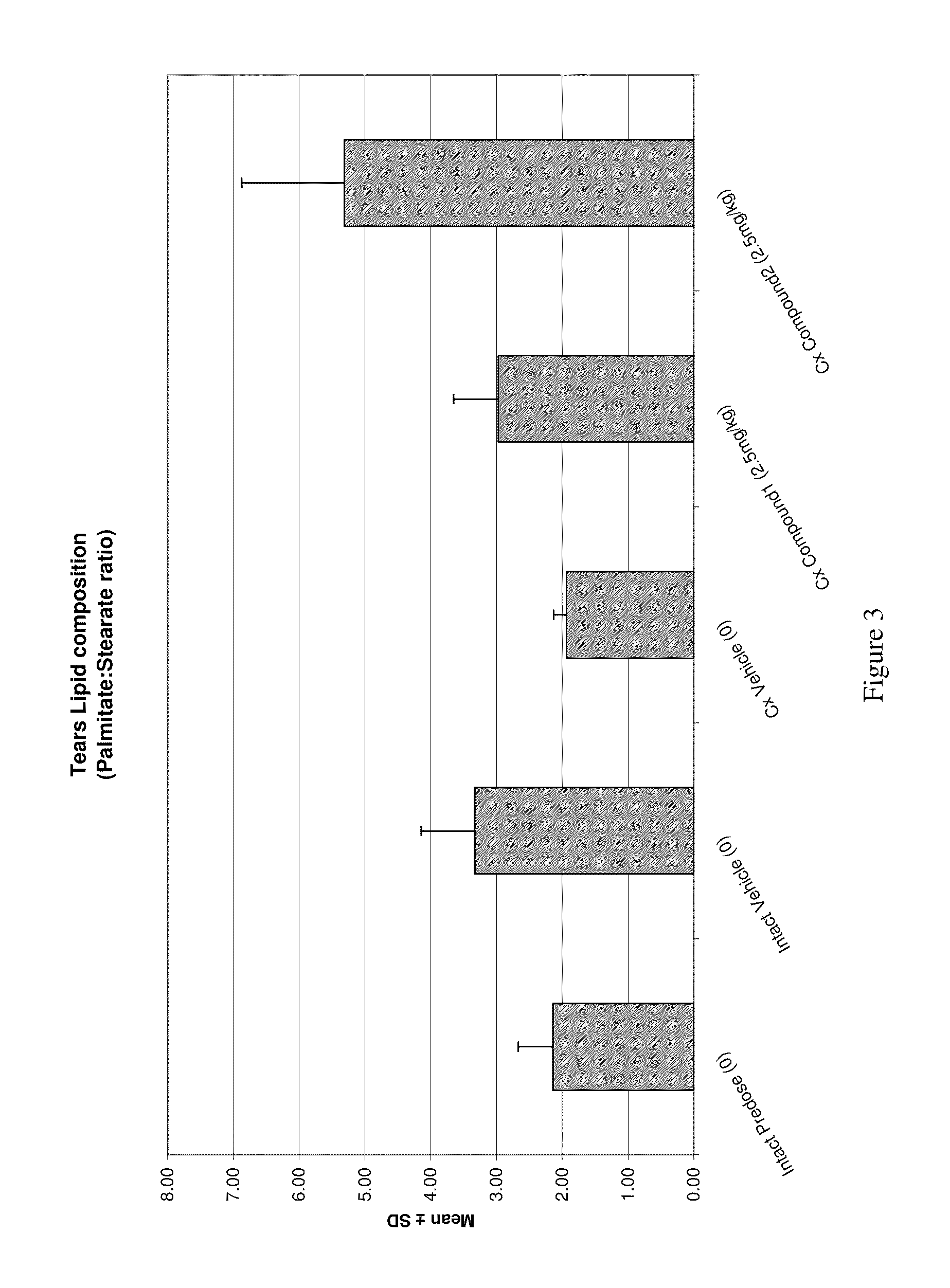Methods of treating meibomian gland dysfunction
- Summary
- Abstract
- Description
- Claims
- Application Information
AI Technical Summary
Benefits of technology
Problems solved by technology
Method used
Image
Examples
example 1
Synthesis of (S)-N-(4-Cyano-3-(trifluoromethyl)phenyl)-3-(4-cyanophenoxy)-2-hydroxy-2-methylpropanamide (Compound 1)
[0132]
[0133](2R)-1-Methacryloylpyrrolidin-2-carboxylic Acid. D-Proline, 14.93 g, 0.13 mol) was dissolved in 71 mL of 2 N NaOH and cooled in an ice bath; the resulting alkaline solution was diluted with acetone (71 mL). An acetone solution (71 mL) of methacryloyl chloride (13.56 g, 0.13 mol) and 2N NaOH solution (71 mL) were simultaneously added over 40 min to the aqueous solution of D-proline in an ice bath. The pH of the mixture was kept at 10-11° C. during the addition of the methacryloyl chloride. After stirring (3 h, room temperature), the mixture was evaporated in vacuo at a temperature at 35-45° C. to remove acetone. The resulting solution was washed with ethyl ether and was acidified to pH 2 with concentrated HCl. The acidic mixture was saturated with NaCl and was extracted with EtOAc (100 mL×3). The combined extracts were dried over Na2SO4, filtered through Cel...
example 2
Synthesis of (S)-N-(4-cyano-3-(trifluoromethyl)phenyl)-3-(4-cyano-3-fluorophenoxy)-2-hydroxy-2-methylpropanamide (Compound 2)
[0138]
(2R)-1-Methacryloylpyrrolidin-2-carboxylic Acid
[0139]D-Proline, 14.93 g, 0.13 mol) was dissolved in 71 mL of 2 N NaOH and cooled in an ice bath; the resulting alkaline solution was diluted with acetone (71 mL). An acetone solution (71 mL) of methacryloyl chloride (13.56 g, 0.13 mol) and 2N NaOH solution (71 mL) were simultaneously added over 40 min to the aqueous solution of D-proline in an ice bath. The pH of the mixture was kept at 10-11° C. during the addition of the methacryloyl chloride. After stirring (3 h, room temperature), the mixture was evaporated in vacuo at a temperature at 35-45° C. to remove acetone. The resulting solution was washed with ethyl ether and was acidified to pH 2 with concentrated HCl. The acidic mixture was saturated with NaCl and was extracted with EtOAc (100 mL×3). The combined extracts were dried over Na2SO4, filtered thro...
example 2a
Synthesis of (S)-N-(4-cyano-3-(trifluoromethyl)phenyl)-3-(4-fluorophenoxy)-2-hydroxy-2-methylpropanamide (Compound 3)
[0146]
[0147]A mixture of bromoamide ((2R)-3-bromo-N-[4-cyano-3-(trifluoromethyl)phenyl]-2-hydroxy-2-methylpropanamide (44.0 g, 125 mmol), anhydrous K2CO3 (51.9 g, 376 mmol) in 800 mL of acetone was heated to reflux for 2 h, which monitored by TLC indicated complete conversion to the epoxy intermediates. After cooling to room temperature, the solution was filtered through the Celite 545 pad to remove insoluble solid. The solution was concentrated under reduced pressure. To the flask was added additional anhydrous K2CO3 (34.6 g, 250 mmol) and 4-fluorophenol (14.05 g, 125 mmol) in 800 mL of methylethylketone and heated to reflux overnight. Then, the solution was through Celite 545 pad and concentrated under reduced pressure, diluted to extra EtOAc, washed with water, saturated NaHCO3, water, dried by anhydrous MgSO4, concentrated and purified by column chromatography (Et...
PUM
| Property | Measurement | Unit |
|---|---|---|
| Molar density | aaaaa | aaaaa |
| Molar density | aaaaa | aaaaa |
| Molar density | aaaaa | aaaaa |
Abstract
Description
Claims
Application Information
 Login to View More
Login to View More - R&D
- Intellectual Property
- Life Sciences
- Materials
- Tech Scout
- Unparalleled Data Quality
- Higher Quality Content
- 60% Fewer Hallucinations
Browse by: Latest US Patents, China's latest patents, Technical Efficacy Thesaurus, Application Domain, Technology Topic, Popular Technical Reports.
© 2025 PatSnap. All rights reserved.Legal|Privacy policy|Modern Slavery Act Transparency Statement|Sitemap|About US| Contact US: help@patsnap.com



